To shop ethically, focus on brands committed to fairness, transparency, and environmental responsibility. Look for certifications like GOTS, Fair Trade, or B Corp to verify social and environmental standards. Prioritize quality over quantity by choosing durable, well-made pieces that last longer. Support local artisans, shop secondhand, and care for your clothes to extend their lifespan. If you’re curious about making more impactful choices, there’s plenty more to explore.
Key Takeaways
- Research brands’ transparency, certifications (GOTS, Fair Trade, B Corp), and supply chain practices before purchasing.
- Prioritize durable, timeless clothing made from eco-friendly materials like organic cotton, recycled fabrics, or Tencel.
- Support local, small-scale producers and buy secondhand to reduce environmental impact and promote ethical labor.
- Properly care for garments to extend lifespan and minimize waste through gentle washing, air drying, and mending.
- Advocate for systemic change by supporting policies and campaigns that promote sustainable textile production and fair labor practices.
Understanding the Principles of Ethical Fashion
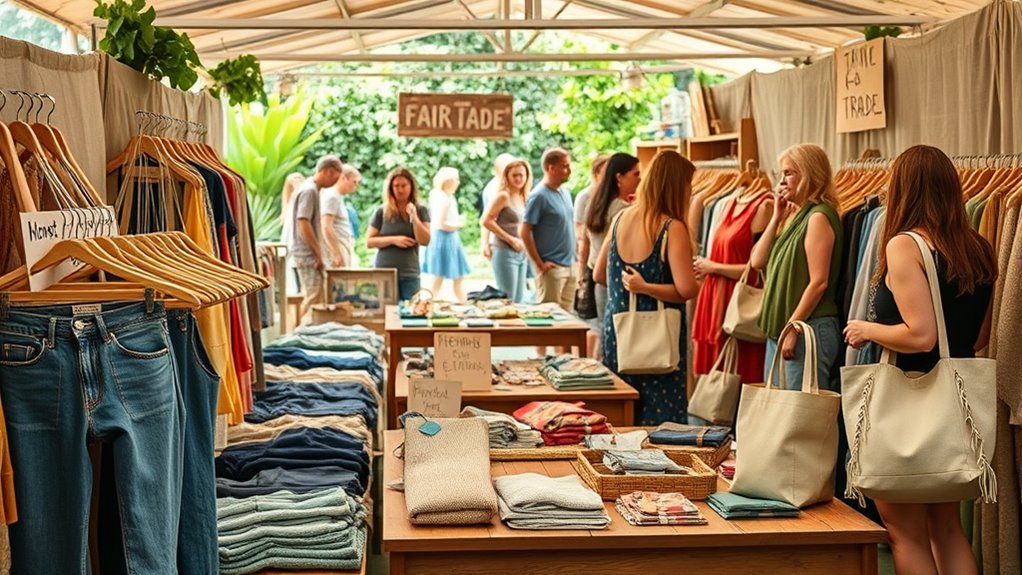
Have you ever wondered what truly makes fashion ethical? Ethical fashion is built on principles that prioritize fairness, transparency, and environmental responsibility. When you shop ethically, you support brands that treat workers fairly by providing safe conditions and fair wages. It also means choosing clothing made with sustainable materials that don’t harm the planet, like organic cotton or recycled fabrics. Transparency is key—ethical brands openly share their supply chain practices, so you know where your clothes come from. Additionally, ethical fashion encourages durability and timeless design, reducing waste from fast fashion cycles. Understanding the importance of privacy policies and how they influence your online shopping experience can help you make more informed and responsible choices. Recognizing the personality traits of brands can further assist you in selecting companies that genuinely align with your values. By understanding these core principles, you empower yourself to make conscious decisions that align with your values, helping create a more sustainable and equitable fashion industry.
Recognizing Certified Sustainable Brands
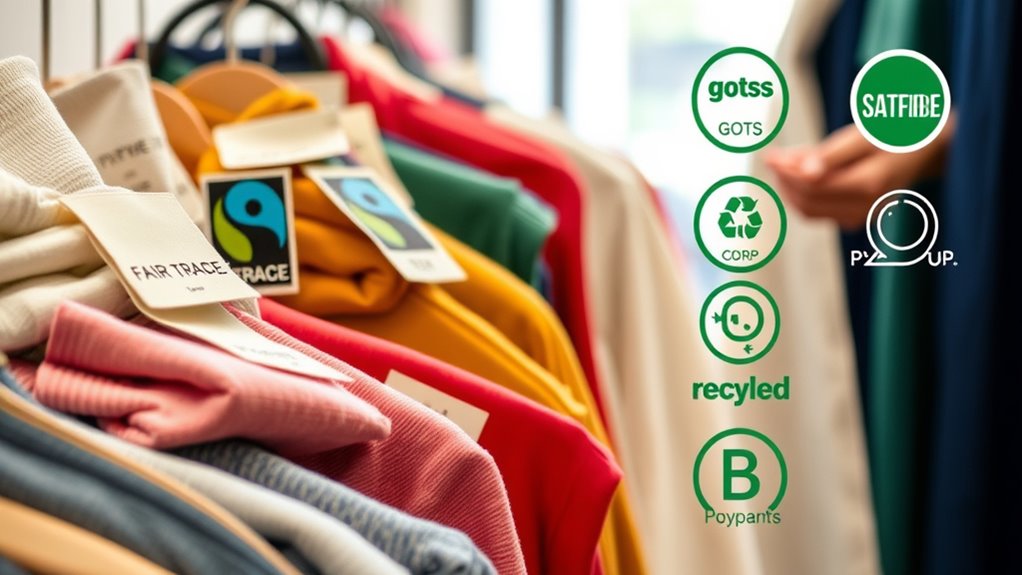
How can you tell if a brand truly adheres to sustainable practices? The key is to look for credible certifications. Certified sustainable brands display labels from recognized organizations like GOTS, Fair Trade, or B Corp. These certifications verify that the company meets strict environmental, social, and ethical standards. When shopping, check product tags or the brand’s website for these symbols. Keep in mind, though, not all eco-friendly claims are certified, so do some research on the brand’s transparency and reporting practices. Certified brands are committed to accountability, making it easier for you to support genuinely sustainable companies. Additionally, understanding certification standards can help you better evaluate a brand’s commitment to sustainability and ethical practices. Recognizing the importance of transparency ensures you are making informed choices and holding brands accountable. Supporting brands with clear social responsibility policies can further ensure that your purchases align with your values. Taking the time to learn about sustainable manufacturing processes can also help you distinguish truly ethical brands from those making false claims. Dog breeds can also serve as a reminder to consider the ethical treatment of animals and the importance of responsible sourcing. By prioritizing certified labels, you can confidently align your purchases with your values and make a real impact.
Prioritizing Quality Over Quantity

Choosing quality over quantity is essential for sustainable fashion because well-made items last longer and reduce waste. Instead of buying many cheaper pieces, invest in durable clothing that withstands wear and tear. High-quality garments often use better stitching and fabrics, meaning fewer replacements and less environmental impact. To help you decide, consider this comparison:
| Aspect | Fast Fashion | Quality Fashion |
|---|---|---|
| Durability | Short-lived, prone to damage | Long-lasting, sturdy |
| Cost | Lower upfront, higher over time | Higher upfront, cost-effective |
| Environmental Impact | High due to frequent disposal | Lower, fewer items discarded |
Prioritize timeless styles and well-constructed pieces to build a sustainable wardrobe that lasts. Incorporating ethical considerations into your shopping habits can further enhance the positive impact on both the environment and the communities involved in production. Additionally, selecting durable materials can greatly extend the lifespan of your clothing and reduce the need for frequent replacements. Paying attention to fabric quality and craftsmanship can also ensure your investment remains functional and stylish for years to come.
Exploring Eco-Friendly Materials and Fabrics

You can make a big impact by choosing eco-friendly fabrics like organic cotton, recycled materials, bamboo, and Tencel. These options reduce environmental harm and often feel just as comfortable as traditional textiles. Exploring these materials helps you shop more sustainably and supports better farming and manufacturing practices. Additionally, selecting fabrics known for their environmental benefits encourages the development of more sustainable fashion industries. Being aware of sustainable manufacturing practices can further guide your choices toward brands committed to ethical production methods. Incorporating natural materials such as linen or hemp can enhance the eco-friendliness of your wardrobe and promote more sustainable resource use. Understanding the environmental impact of different textiles allows consumers to make more informed decisions and support companies dedicated to reducing their ecological footprint. Incorporating vetted products ensures you are making well-informed, environmentally conscious choices.
Organic Cotton Benefits
Organic cotton offers a sustainable alternative to conventional cotton by reducing the use of harmful pesticides and synthetic fertilizers. This means fewer chemicals pollute the soil, water, and air, making it safer for farmers and nearby ecosystems. Because organic cotton is grown without synthetic inputs, it typically requires less water, conserving this precious resource. Additionally, organic farming practices promote healthier soil and support biodiversity. Wearing organic cotton helps you avoid exposure to toxic residues often found in conventional fabrics. It’s also a durable, breathable material that keeps you comfortable while supporting environmentally friendly farming methods. By choosing organic cotton, you contribute to reducing pollution, conserving resources, and promoting ethical farming practices—making your fashion choices better for the planet and its people. Organic cotton is also gaining popularity among eco-conscious consumers seeking sustainable wardrobe options. Choosing organic cotton can also encourage the adoption of sustainable farming methods that prioritize environmental health and resource efficiency. Promoting organic cotton production supports environmentally friendly agriculture, which benefits both ecosystems and local communities. Supporting organic cotton farming can also help reduce the carbon footprint associated with conventional textile production. Incorporating organic cotton into your wardrobe can also help protect biodiversity by supporting farming systems that minimize habitat disruption.
Recycled Fabric Options
Building on the benefits of organic cotton, recycled fabrics offer another innovative way to reduce environmental impact in fashion. By repurposing materials like plastic bottles, old textiles, and industrial waste, recycled fabrics minimize landfill waste and lower resource consumption. For example, recycled polyester is made from plastic bottles, conserving petroleum and reducing greenhouse gas emissions. Similarly, recycled nylon uses waste fishing nets and carpets, preventing ocean pollution. These fabrics often require less water and energy during production compared to traditional materials. When shopping, look for labels indicating recycled content, and choose brands committed to sustainability. Incorporating recycled fabrics into your wardrobe helps close the circular economy in fashion, supporting a circular economy and decreasing demand for virgin materials. Additionally, many recycled fabrics are produced using eco-friendly processes that further lessen environmental impact. Using sustainable textiles can also encourage manufacturers to adopt greener production methods. Embracing eco-friendly materials not only benefits the environment but also promotes innovation within the fashion industry. By selecting recycled and sustainable textiles, consumers can make more environmentally conscious choices and support innovative manufacturing practices. It’s a practical step toward more eco-conscious choices.
Bamboo and Tencel Advantages
Bamboo and Tencel are two eco-friendly fabrics gaining popularity for their sustainability benefits. Bamboo grows quickly without needing pesticides or heavy water, making it highly renewable. It also requires less land, reducing environmental impact. Bamboo’s rapid growth makes it a particularly sustainable resource. Tencel, made from sustainably farmed eucalyptus trees, uses a closed-loop process that recycles water and chemicals, minimizing waste. Both fabrics are naturally soft, breathable, and moisture-wicking, ensuring comfort while reducing reliance on synthetic materials. They’re biodegradable, which means they break down naturally and don’t contribute to microplastic pollution. Choosing clothing made from bamboo or Tencel supports eco-conscious manufacturing practices and helps lessen your carbon footprint. Additionally, high smoke point oils recommended for frying have a minimal environmental impact and help maintain the fabric’s durability and quality. Overall, these fabrics offer a stylish, sustainable alternative to conventional textiles, aligning your wardrobe with your values.
Supporting Local and Small-Scale Producers
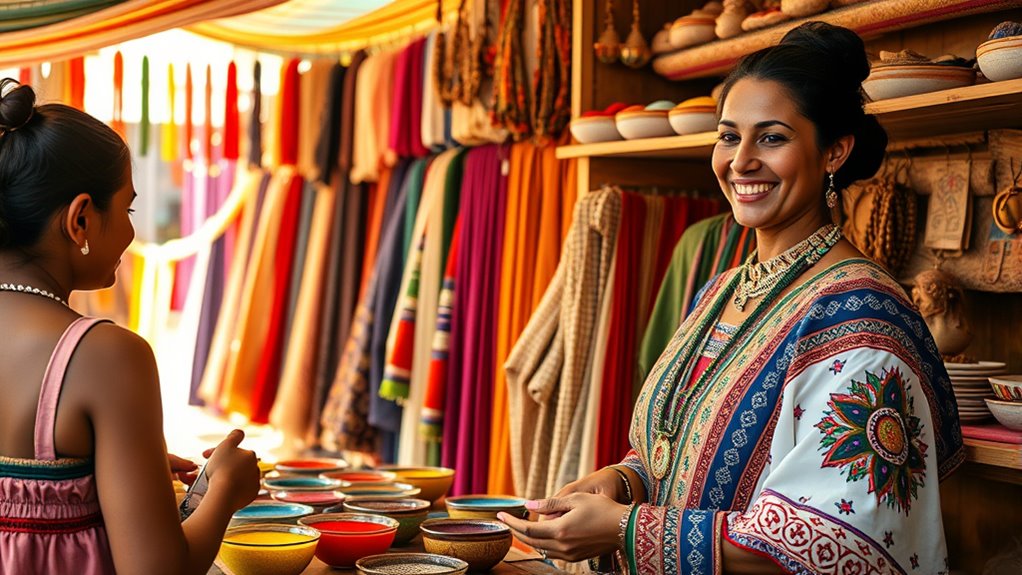
Have you ever considered how supporting local and small-scale producers can make a real difference in sustainable fashion? When you choose to shop from local artisans or small brands, you help reduce the environmental impact associated with mass production and long supply chains. These producers often use eco-friendly materials, adopt ethical labor practices, and prioritize quality over quantity. By supporting them, you encourage a more transparent and accountable fashion industry. Additionally, you promote local economies and preserve traditional craftsmanship. Your purchases become more meaningful because they directly benefit the community and artisans behind each item. This conscious choice not only minimizes your carbon footprint but also fosters a more ethical and sustainable approach to fashion, making your wardrobe a reflection of your values.
Researching Brand Transparency and Supply Chains
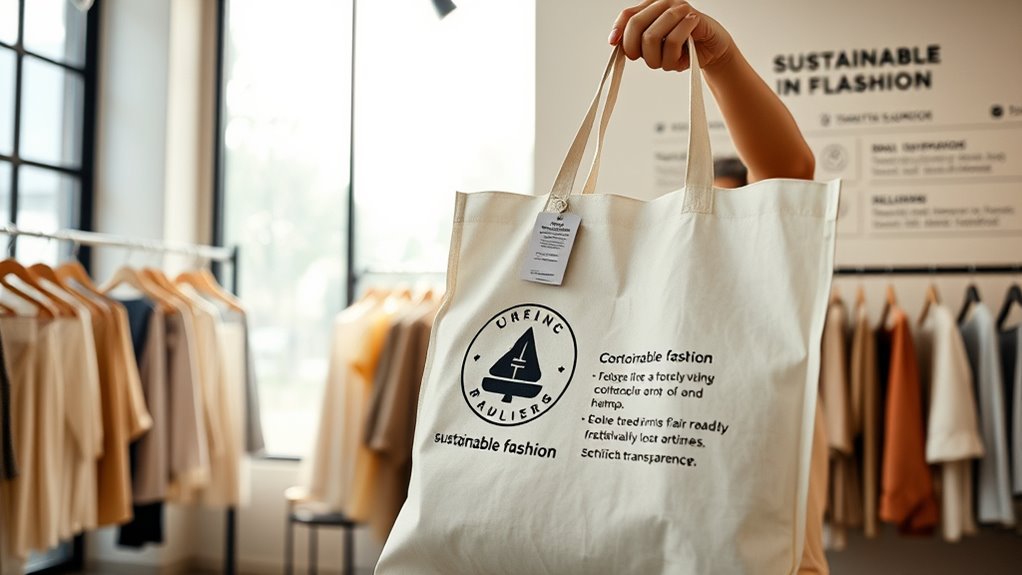
To shop ethically, you need to verify a brand’s transparency by checking their certifications and supply chain details. Look into where materials come from and how products are made to guarantee ethical practices. This research helps you make informed choices that support sustainability and fair labor.
Investigate Brand Certifications
How can you confidently trust a brand’s commitment to sustainability? One way is to investigate their certifications. Certifications are like badges of authenticity, proving a brand meets specific environmental and ethical standards. Look for labels such as Fair Trade, GOTS (Global Organic Textile Standard), or B Corp. These certifications indicate rigorous third-party audits, ensuring transparency and accountability.
When researching, consider these points:
- Verify if the certification is recognized internationally or locally
- Check the certifying organization’s credibility and standards
- Review what specific aspects (e.g., labor practices, ecological impact) the certification covers
Trace Material Sourcing
Ever wonder where a brand’s materials truly come from? To shop ethically, you need to trace their supply chains. Start by researching brand transparency—look for companies that openly share their sourcing info. You can ask questions like: Where are their fibers grown? Are the farms eco-friendly? Do they ensure fair labor practices? Understanding supply chains helps you avoid unethical practices and supports responsible sourcing. Here’s a quick look at key sourcing info:
| Material | Country of Origin | Certification/Standards |
|---|---|---|
| Cotton | India | Fair Trade, Organic |
| Wool | Australia | Responsible Wool Standard |
| Silk | China | OEKO-TEX |
| Hemp | USA | GOTS Certified |
| Polyester | Vietnam | Recycled Content |
Knowing these details empowers you to make more ethical choices.
Examine Manufacturing Practices
Understanding where your clothing materials come from is just the first step; knowing how garments are made is equally important. When researching brands, look for transparency about their manufacturing practices. Ask questions like: Do they disclose their supply chains? Are factories audited for fair labor conditions? Do they use environmentally friendly methods? To evaluate a brand’s commitment, consider:
- Checking if they publish detailed supply chain reports
- Ensuring factories meet safety and labor standards
- Looking for certifications like Fair Trade or B Corp
Making Thoughtful Purchasing Decisions

When you make purchasing decisions with care, you can substantially reduce your environmental impact and support ethical practices. Start by researching brands to guarantee they prioritize fair labor and sustainable materials. Opt for quality over quantity—buy fewer, better-made pieces that last longer. Check labels for eco-friendly certifications like Fair Trade or GOTS, which indicate responsible sourcing. Consider whether you really need an item before buying, avoiding impulse purchases. When shopping online, read reviews to gauge durability and ethical standards. Be mindful of fast fashion trends that promote disposability. By making informed choices, you support companies committed to transparency and sustainability, ultimately helping create a more ethical fashion industry. Thoughtful purchasing empowers you to wear what aligns with your values.
Caring for Your Garments to Extend Their Lifespan
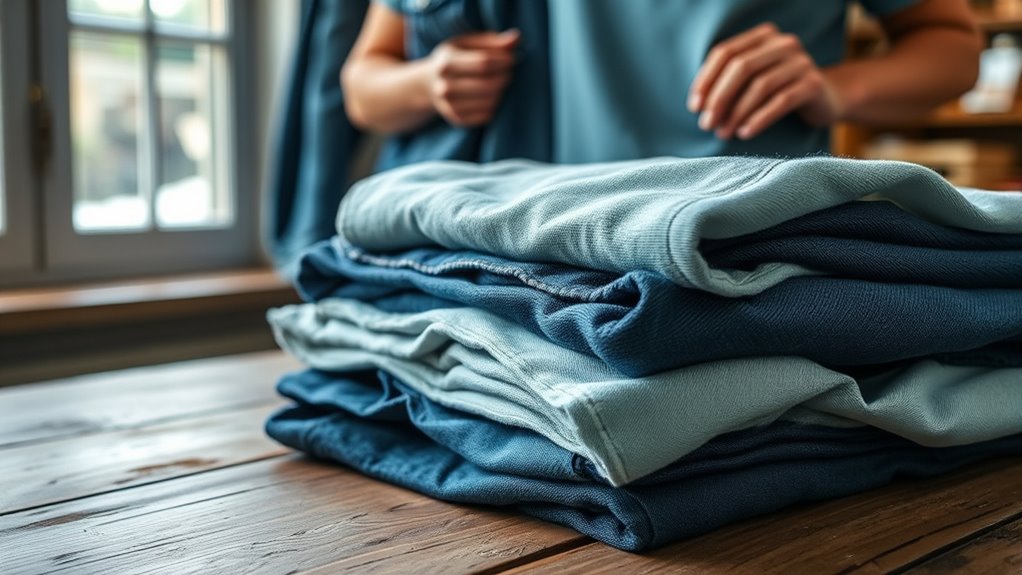
Taking care of your garments is an essential step in making your wardrobe more sustainable. Proper maintenance helps you get the most out of your clothes, reducing waste and the need for frequent replacements. To extend their lifespan, follow these tips:
- Wash clothes in cold water and use eco-friendly detergents to minimize fiber damage and energy use.
- Avoid overloading the washing machine, which can cause unnecessary wear and tear.
- Air dry whenever possible, as tumble drying can weaken fabrics and cause shrinking.
Additionally, mend small tears or loose seams promptly to prevent further damage. Store your clothes properly, folding or hanging them to maintain shape and fabric integrity. These simple habits make a big difference in keeping your wardrobe eco-friendly and durable.
Embracing Secondhand and Vintage Shopping
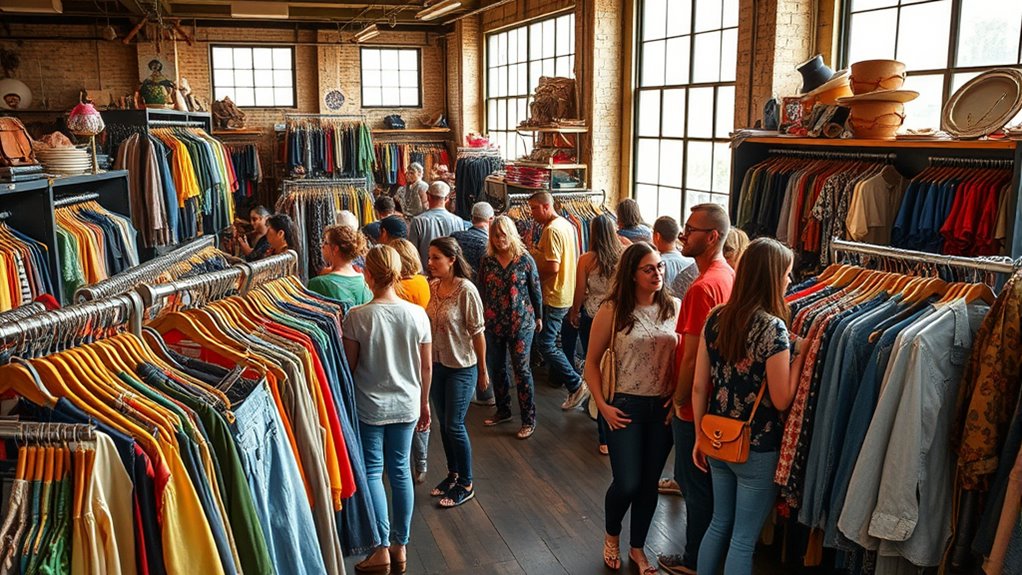
Have you considered how shopping secondhand or vintage can considerably reduce your environmental impact? When you choose thrift stores, consignment shops, or online vintage markets, you extend the life of clothing pieces and reduce demand for new production. This helps cut down on resource use, water consumption, and waste generated by fast fashion. Vintage shopping also offers unique, high-quality items that often last longer than cheaply made fast fashion pieces. Plus, it supports local businesses and keeps clothing out of landfills. To get started, explore local thrift stores, online platforms, or vintage fairs. Be patient, open-minded, and willing to hunt for hidden gems. Embracing secondhand and vintage shopping makes your wardrobe more sustainable while letting you express your individual style.
Advocating and Spreading Awareness for Sustainable Fashion

You can make a real impact by promoting ethical brands and encouraging others to choose sustainable options. Educating your community helps spread awareness and builds support for change. When you advocate for policy updates, you push for systemic shifts that make sustainable fashion accessible to everyone.
Promoting Ethical Brands
Why is it so important to support ethical brands in the fight for sustainable fashion? When you choose ethical brands, you help promote transparency, fair labor practices, and environmentally friendly production. Your support encourages other companies to follow suit and adopt sustainable methods. By spreading awareness, you empower others to make conscious choices.
You can further promote ethical brands by:
- Sharing their stories and values on social media
- Recommending them to friends and family
- Participating in or organizing local sustainable fashion events
Every action amplifies the message that ethical fashion matters. Your advocacy helps shift industry standards and makes sustainable choices more accessible, creating a larger impact for people and the planet.
Educating Communities Effectively
How can communities effectively embrace sustainable fashion and inspire change? The key is education. Start by sharing clear, accessible information about the impacts of fast fashion and the benefits of sustainable choices. Host workshops, social media campaigns, or community events that highlight eco-friendly brands and practices. Encourage local influencers and leaders to speak out, creating a ripple effect that motivates others. Use real stories to connect emotionally and make the issues relatable. Distribute educational materials like flyers or guides that simplify sustainable fashion concepts. Foster open discussions where people can ask questions and share ideas. When communities understand the importance of their choices, they’re more likely to support ethical brands and adopt sustainable habits, creating a lasting culture of conscious consumption.
Influencing Policy Change
Have you considered the powerful role policy change plays in advancing sustainable fashion? When you advocate for better regulations, you help create systemic shifts that benefit workers, the environment, and consumers. You can influence policy by:
- Supporting campaigns that push for stricter environmental standards in textile production
- Contacting your representatives to endorse legislation promoting fair labor practices
- Participating in public consultations to voice concerns about fast fashion’s impact
Your involvement amplifies awareness and pressures policymakers to act. By staying informed and engaging with advocacy groups, you help shape policies that prioritize sustainability. Remember, change often starts with individual voices, and collective action can drive meaningful reform in the fashion industry. Your efforts contribute to a more ethical, transparent, and sustainable future.
Frequently Asked Questions
How Can I Verify the Ethical Claims of a Fashion Brand?
You can verify a fashion brand’s ethical claims by researching their transparency reports, certifications, and supply chain practices. Look for third-party labels like Fair Trade, GOTS, or B Corp. Check their website for detailed information on sourcing, working conditions, and environmental impact. Also, read reviews and reports from trusted sources. Don’t hesitate to ask brands directly for proof of their ethical commitments; transparency is key.
What Are the Environmental Impacts of Different Textile Dyes?
Think of textile dyes as a double-edged sword—vibrant colors often come at an environmental cost. Synthetic dyes, while colorful, release harmful chemicals into water systems, harming aquatic life and polluting resources. Natural dyes, though eco-friendlier, can require large amounts of water and land. You should look for brands that use eco-friendly dyes, like low-impact or natural options, to reduce your fashion’s environmental footprint.
How Do I Identify Truly Sustainable Fashion on a Budget?
To spot truly sustainable fashion on a budget, look for brands that prioritize transparency about their sourcing and manufacturing processes. Check for certifications like Fair Trade or GOTS, which indicate eco-friendly practices. Opt for secondhand shops or thrift stores to find quality pieces at lower prices. Focus on versatile, durable clothing that lasts longer, reducing the need for frequent replacements and making your sustainable choices more affordable.
What Are the Social Implications of Fast Fashion Practices?
Think of fast fashion as a quicksand trap—initially tempting but ultimately destructive. When you support fast fashion, you contribute to social issues like labor exploitation and unsafe working conditions, often in developing countries. For example, many brands overlook fair wages, perpetuating inequality. Your choices impact workers’ lives and global communities, so by shopping consciously, you help pull others out of that trap and foster fairer, more ethical practices.
How Can I Influence Brands to Adopt More Sustainable Policies?
To influence brands to adopt more sustainable policies, you can start by supporting companies committed to ethical practices. Share your values on social media, write reviews, and participate in campaigns demanding transparency. Reach out directly to brands with your concerns and encourage others to do the same. Your purchasing choices and voice matter; collectively, they can push brands toward more responsible and eco-friendly approaches.
Conclusion
By choosing to shop thoughtfully, you’re planting seeds of change in a garden that blooms with kindness and care. Every mindful purchase becomes a gentle ripple, shaping a future where fashion’s beauty is intertwined with respect for people and the planet. When you embrace sustainable choices, you’re weaving a tapestry of hope and responsibility, ensuring that your wardrobe nurtures both style and conscience—creating a brighter, more harmonious world for all.









